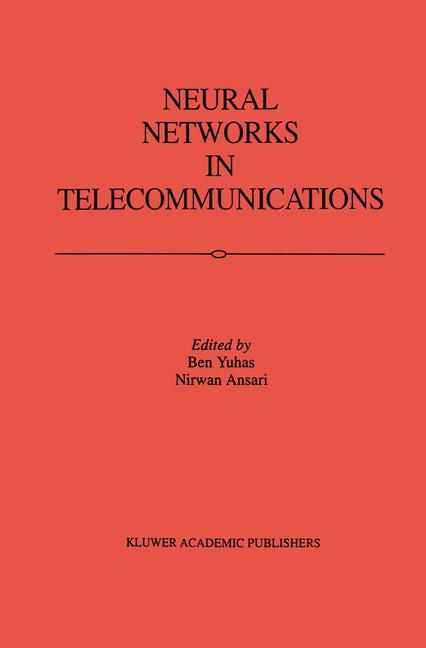
Zustellung: Mo, 30.12. - Do, 02.01.25
Versand in 2 Tagen
VersandkostenfreiBestellen & in Filiale abholen:
Neural Networks in Telecommunications consists of a carefully edited collection of chapters that provides an overview of a wide range of telecommunications tasks being addressed with neural networks. These tasks range from the design and control of the underlying transport network to the filtering, interpretation and manipulation of the transported media. The chapters focus on specific applications, describe specific solutions and demonstrate the benefits that neural networks can provide. By doing this, the authors demonstrate that neural networks should be another tool in the telecommunications engineer's toolbox.
Neural networks offer the computational power of nonlinear techniques, while providing a natural path to efficient massively-parallel hardware implementations. In addition, the ability of neural networks to learn allows them to be used on problems where straightforward heuristic or rule-based solutions do not exist. Together these capabilities mean that neural networks offer unique solutions to problems in telecommunications.
For engineers and managers in telecommunications, Neural Networks in Telecommunications provides a single point of access to the work being done by leading researchers in this field, and furnishes an in-depth description of neural network applications.
Neural networks offer the computational power of nonlinear techniques, while providing a natural path to efficient massively-parallel hardware implementations. In addition, the ability of neural networks to learn allows them to be used on problems where straightforward heuristic or rule-based solutions do not exist. Together these capabilities mean that neural networks offer unique solutions to problems in telecommunications.
For engineers and managers in telecommunications, Neural Networks in Telecommunications provides a single point of access to the work being done by leading researchers in this field, and furnishes an in-depth description of neural network applications.
Inhaltsverzeichnis
1 Introduction.- 1 What is a Neural Network?.- 2 Computing with Neural Networks.- 3 Building the Correct Neural Network.- 4 When are Neural Networks Appropriate?.- 2 Neural Networks for Switching.- 1 Introduction.- 2 Switching.- 3 Neural Circuit Design.- 4 Neural Approaches to Switching.- 5 Conclusion.- 3 Routing in Random Multistage Interconnection Networks.- 1 Introduction.- 2 The Communication System.- 3 Exhaustive Search and Greedy Routing.- 4 The Neural Network Router.- 5 Performance Measures for Routers.- 6 Simulation Results.- 7 Analysis.- 8 Conclusions and Future Work.- 4 ATM Traffic Control Using Neural Networks.- 1 Introduction.- 2 ATM Traffic Control.- 3 Neural Network Applications in the ATM Network.- 4 Adaptive Call Admission Control.- 5 Adaptive Link Capacity Control.- 6 Further Research Directions.- 5 Learning from Rare Events: Dynamic Cell Scheduling for ATM Networks.- 1 Introduction.- 2 ATM Networking.- 3 On-Line Dynamic Programming.- 4 Experimental Evaluation.- 5 Simulations.- 6 Conclusions.- 6 A Neural Model for Adaptive Congestion Control in ATM Networks.- 1 Introduction.- 2 Problem Formulation.- 3 Adaptive Learning Rate Algorithm.- 4 Neural Network Control Scheme.- 5 Simulation Results.- 6 Summary.- 7 Structure and Performance of Neural Nets in Broadband System Admission Control.- 1 Introduction.- 2 Neural Networks for Connection Admission Control.- 3 Example of a Neural Network for Admission Control.- 4 Conclusions.- 8 Neural Network Channel Equalization.- 1 Introduction.- 2 A Brief Introduction to Digital Transmission Theory.- 3 Signal Detection and Estimation.- 4 Two Dimensional Signalling and Complex Neural Networks.- 5 Summary.- 9 Neural Networks as Excisers for Spread Spectrum Communication Systems.- 1 Introduction.- 2 Time Domain Processing.-3 Conclusions.- 10 Static and Dynamic Channel Assignment Using Simulated Annealing.- 1 Problem Description.- 2 Existing Approaches.- 3 Applying Simulated Annealing to the Static CAP.- 4 Simulated Annealing in a Running System.- 5 Conclusions.- 11 Cellular Mobile Communication Design Using Self-Organizing Feature Maps.- 1 Introduction.- 2 Mobile Network Planning.- 3 Traffic Density Determination using a Self-organizing Feature Map.- 4 The Main Algorithm.- 5 Experimental Results.- 6 Conclusions.- 12 Automatic Language Identification Using Telephone Speech.- 1 Introduction.- 2 Background.- 3 A Telephone Speech Corpus For Automatic Language Identification.- 4 Human Listening Experiments.- 5 A Segmental Approach to Automatic Language Identification.- 6 Summary and Future Work.- 13 Text-Independent Talker Verification Using Cohort Normalized Scores.- 1 Introduction.- 2 Talker Identification Background.- 3 Related Work.- 4 Cohort Normalization.- 5 STIMIT.- 6 Talker Identification System.- 7 Vector Quantization.- 8 Experiments on 90 Talkers.- 9 Experiments on All 630 Talkers.- 10 Multilayer Perceptron.- 11 Fixed Versus Variable Training Sentences.- 12 Preliminary Experiment on Real Telephone Speech.- 13 Discussion.- 14 Conclusion.- 14 Neural Network Applications in Character Recognition and Document Analysis.- 1 Introduction.- 2 The Character Recognition Process.- 3 The Basic Recognizer: LeNet.- 4 Segmentation.- 5 Normalization.- 6 Finding the Region of Interest.- 7 Additional Applications.- 8 Conclusions.- 15 Image Vector Quantization by Neural Networks.- 1 Introduction.- 2 Neural Networks for Vector Quantization.- 3 Neural Networks for Adaptive Vector Quantization.- 4 Conclusions.- 16 Managing the Infoglut: Information Filtering Using Neural Networks.- 1 Introduction.- 2 Previous work on filtering.- 3 Neural Networks for Filtering.- 4 Reinforcement learning AIR.- 5 An Unsupervised Classifier ART.- 6 Experimental determination of filter validity.- 7 Future Directions.- 17 Empirical Comparisons of Neural Networks and Statistical Methods for Classification and Regression.- 1 Introduction.- 2 Two Problems.- 3 Regression and Classification Methodologies.- 4 Results on Regression for Switch Memory.- 5 Results on Classification of DSO-Rate Traffic.- 6 Discussion.- 18 A Neurocomputing Approach to Optimizing the Performance of a Satellite Communication Network.- 1 Satellite Communications.- 2 The Self-organization Method.- 3 The Cost Minimization Method.- 4 Discussion.
Produktdetails
Erscheinungsdatum
04. Oktober 2012
Sprache
englisch
Auflage
Softcover reprint of the original 1st ed. 1994
Seitenanzahl
388
Herausgegeben von
Nirwan Ansari, Ben Yuhas
Verlag/Hersteller
Produktart
kartoniert
Abbildungen
XIV, 369 p.
Gewicht
587 g
Größe (L/B/H)
235/155/21 mm
Sonstiges
Paperback
ISBN
9781461361794
Entdecken Sie mehr
Bewertungen
0 Bewertungen
Es wurden noch keine Bewertungen abgegeben. Schreiben Sie die erste Bewertung zu "Neural Networks in Telecommunications" und helfen Sie damit anderen bei der Kaufentscheidung.










